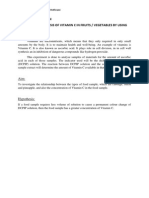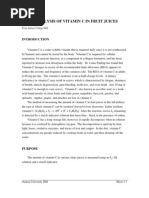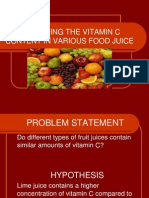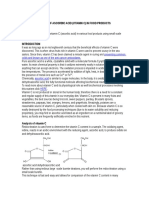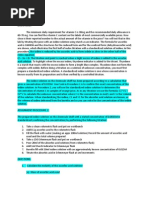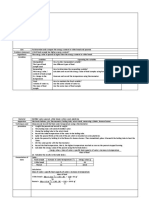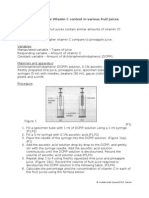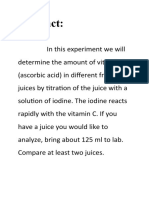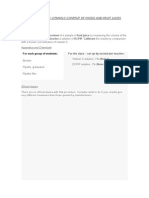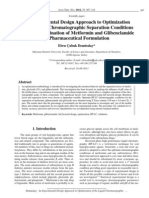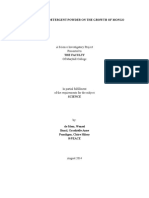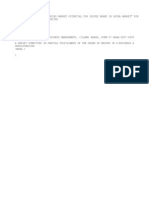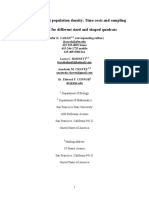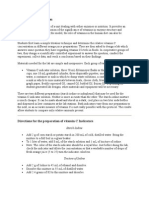DCPIP
DCPIP
Uploaded by
gabCopyright:
Available Formats
DCPIP
DCPIP
Uploaded by
gabCopyright
Available Formats
Share this document
Did you find this document useful?
Is this content inappropriate?
Copyright:
Available Formats
DCPIP
DCPIP
Uploaded by
gabCopyright:
Available Formats
PAPER 3 (SEMINAR 2021) 2022
EXPERIMENT 9.2 TO DETERMINE THE VITAMIN C CONTENT IN VARIOUS FRUIT JUICES.
You have to carry out an experiment to determine the concentration/percentage of vitamin C in fruit juice.
Diagram 1, below shows set up apparatus for the experiment.
(a) Plan your experiment using the apparatus and materials provided. Your procedure should include:
Method to handle the variables:
Precautionary steps:
1. 1 ml of 1.0% DCPIP solution is place in a specimen tube using 1ml syringe needle
2. 5 ml syringe needle with 0.1% ascorbic acid solution. Ensure that there are no air bubbles trapped in
it.
3. Insert the tip of the syringe needle into the specimen tube
4. Ascorbic acid is added drop by drop into the 1% DCPIP solution while stirring slowly until the blue
colour of the DCPIP solution is decolorised. Do not shake the tube vigorously
5. Record the volume of the ascorbic acid solution needed to decolorised the blue colour of the DCPIP
solution.
6. Step 1 to 5 are repeated twice to get the average volume of ascorbic acid needed
7. Step 1 to 6 are repeated using the fresh lemon juice and cooked lemon juice
8. Volume of each juice needed to decolourise the blue colour of DCPIP solution is recorded in the
table
9. Calculate the percentage and the concentration of vitamin C in each of the fruit juices using the
formulae below.
Concentration of Vitamin C in fruit juice (mg 𝒎𝒍−𝟏 ) =
𝑣𝑜𝑙𝑢𝑚𝑒 𝑜𝑓 0.1% 𝑎𝑠𝑐𝑜𝑟𝑏𝑖𝑐 𝑎𝑐𝑖𝑑 𝑠𝑜𝑙𝑢𝑡𝑖𝑜𝑛
𝑥 1.0𝑚𝑔𝑚𝑙
𝑣𝑜𝑙𝑢𝑚𝑒 𝑜𝑓 𝑓𝑟𝑢𝑖𝑡 𝑗𝑢𝑖𝑐𝑒 𝑢𝑠𝑒𝑑
Percentage of Vitamin C in fruit juice (%) =
𝑣𝑜𝑙𝑢𝑚𝑒 𝑜𝑓 0.1% 𝑎𝑠𝑐𝑜𝑟𝑏𝑖𝑐 𝑎𝑐𝑖𝑑 𝑠𝑜𝑙𝑢𝑡𝑖𝑜𝑛
𝑥 0.1%
𝑣𝑜𝑙𝑢𝑚𝑒 𝑜𝑓 𝑓𝑟𝑢𝑖𝑡 𝑗𝑢𝑖𝑐𝑒 𝑢𝑠𝑒𝑑
TTC BIOLOGY, SPM SEMINAR 2021 Page 1
PAPER 3 (SEMINAR 2021) 2022
The volumes of fruit juices used to decolourise 1 ml DCPIP solution are shown in Table 1.1.
Solution/Juice Volume of solution/juice required to decolorised
DCPIP solution (ml)
Reading 1 Reading 2 Average
Ascorbic acid 1.0 1.0 1.0
Fresh lemon juice 1.7 1.8 1.6
Cooked lemon juice 2.9 2.7 2.8
(a) i. Based on experiment, state one observation. [1m]
The volume of fresh lemon juice used to decolourise 1 mi DCPIP solution is 1.6 ml
ii. State the inference based on the observation in (a)(i). [1m]
Fresh lemon juice used to decolourise 1ml of DCPIP is less, concentration of vitamin c is the highest.
(b) State the variables for this experiment.
Manipulated variables : Type of fruit juices used
Responding variables: Volume of fruit juices needed to decolourise 1ml of DCPIP solution
Constant variable: Volume of DCPIP solution and concentration of ascorbic acid solution
(c) State the hypothesis for this experiment. [2m]
Fresh lemon juice has higher percentage /concentration of vitamin C compared to cooked lemon juice.
(d) Based on this experiment, calculate the concentration of vitamin C of each fruit juice using the
formula below:
• Percentage of vitamin C in fruit juice
𝑉𝑜𝑙𝑢𝑚𝑒 𝑜𝑓 0.1% 𝑎𝑠𝑐𝑜𝑟𝑏𝑖𝑐 𝑎𝑐𝑖𝑑 𝑠𝑜𝑙𝑢𝑡𝑖𝑜𝑛
𝑃𝑒𝑟𝑐𝑒𝑛𝑡𝑎𝑔𝑒 𝑜𝑓 𝑉𝑖𝑡 𝐶 𝑖𝑛 𝑓𝑟𝑢𝑖𝑡 𝑗𝑢𝑖𝑐𝑒: 𝑥 0.1%
𝑣𝑜𝑙𝑢𝑚𝑒 𝑜𝑓 𝑓𝑟𝑢𝑖𝑡 𝑗𝑢𝑖𝑐𝑒
• Concentration of vitamin C in fruit juice
𝑉𝑜𝑙𝑢𝑚𝑒 𝑜𝑓 0.1% 𝑎𝑠𝑐𝑜𝑟𝑏𝑖𝑐 𝑎𝑐𝑖𝑑 𝑠𝑜𝑙𝑢𝑡𝑖𝑜𝑛
𝐶𝑜𝑛𝑐𝑒𝑛𝑡𝑟𝑎𝑡𝑖𝑜𝑛 𝑜𝑓 𝑉𝑖𝑡 𝐶 𝑖𝑛 𝑓𝑟𝑢𝑖𝑡 𝑗𝑢𝑖𝑐𝑒: 𝑥 1.0𝑚𝑔𝑚𝑙 −1
𝑣𝑜𝑙𝑢𝑚𝑒 𝑜𝑓 𝑓𝑟𝑢𝑖𝑡 𝑗𝑢𝑖𝑐𝑒
TTC BIOLOGY, SPM SEMINAR 2021 Page 2
PAPER 3 (SEMINAR 2021) 2022
(e) State the operational definition for concentration of vitamin C. [2m]
Vitamin C is the content of ascorbic acid in fresh lemon juice and cooked lemon juice that can be
determined with the volume of fruit juice used to decolourise 1 ml DCPIP solution or percentage/
concentration of vitamin C is affected by different samples of fruit juices.
(f) Explain the relationship between the concentration of vitamin C and the sample of fruit juice. [3m]
Fresh lemon juice has higher concentration of vitamin C compared to cooked lemon juice
because ascorbic acid in the cooked lemon juice has been destroyed by high temperatures
causing DCPIP to decolourise faster in fresh lemon juice /causing DCPIP to decolourise slower in the
cooked lemon juice
(g) Ali prepared a jar of lime juice. After drinking some of the lime juice, he left the juice exposed to the
surrounding. Experiment is repeated by using the exposed lime juice. Predict the volume of exposed
lime juice that needed to decolourise 1 ml DCPIP solution.
Explain your prediction. [2m]
P1 - the volume of exposed lime juice is increase /more than 1.0ml
P2- because (exposed lime juice) contains less / lack ascorbic acid
P3 - ascorbic acid destroy by oxidation.
TTC BIOLOGY, SPM SEMINAR 2021 Page 3
PAPER 3 (SEMINAR 2021) 2022
(h) The following list shows fruits that contain high and low content of vitamin C. [3m]
Pineapple, papaya, starfruit, orange, banana, watermelon
High content of Vitamin C Low content of Vitamin C
Pineapple Papaya
Starfruit Watermelon
Orange Banana
TTC BIOLOGY, SPM SEMINAR 2021 Page 4
PAPER 3 (SEMINAR 2021) 2022
EXPERIMENT 9.1 DIGESTION OF STARCH IN FOOD SAMPLE
Problem statement
What is the effect of amylase on starch?
Hypothesis
Amylase hydrolyses starch into a reducing sugar.
Variables
• Manipulated: Presence of amylase
• Responding: Presence of reducing sugar
• Fixed: Temperature of water bath at 37°C, concentration of starch suspension and volume of mixture
Materials: 0.5% amylase solution, 1% starch suspension, iodine solution, Benedict’s solution and distilled
water
Apparatus: Tripod stand, Bunsen burner, wire gauze, 500 m/ beaker, test-tube holders, thermometer,
stopwatch, test tubes, droppers, glass rod and measuring cylinder
Procedure
1. Two test tubes are labelled as A and B.
2. 3 m/ of 1 % starch suspension is added to each test tube.
3. Test tube A is filled with 3 m/ of 0.5% amylase solution and test tube B is filled with 3 m/ of distilled
water.
4. Both test tubes are placed in a water bath at a temperature of 37°C for 10 minutes (Figure 9.5).
5. After 10 minutes, 2 m/ of solution is removed from test tube A and placed in a different test tube.
Three drops of Benedict’s solution are added to the test tube and the test tube is heated in a boiling
water bath for 1 minute. The colour of the solution is observed and recorded.
6. Two drops of iodine solution are added to the remaining contents of test tube A. The colour of the
contents is observed and recorded.
7. Steps 5 and 6 are repeated for the contents of test tube B.
TTC BIOLOGY, SPM SEMINAR 2021 Page 5
PAPER 3 (SEMINAR 2021) 2022
Results
Discussion
1. In test tube A, starch is hydrolysed by amylase into maltose. Maltose is a reducing sugar which
produces a brick-red precipitate when tested with Benedict’s solution.
2. Test tube B is a control.
Conclusion
Starch (carbohydrate) is hydrolysed into maltose by amylase. The hypothesis is accepted.
YOUTUBE CHANNEL: MRSM CHANNEL
Link for experiment:
https://www.youtube.com/watch?v=d2ZSv5blCtM&list=PL0XgH9Q_F5k5M32PQJsKva4jzjbRb0f_F&inde
x=11&t=32s
TTC BIOLOGY, SPM SEMINAR 2021 Page 6
You might also like
- Visualizing Human Biology Lab Manual 11Document519 pagesVisualizing Human Biology Lab Manual 11Ioana Farcaș0% (1)
- Biology IA 2Document7 pagesBiology IA 2mushiNo ratings yet
- Vitamin C Core Practical Write Up PDFDocument2 pagesVitamin C Core Practical Write Up PDFMichael Collin0% (1)
- Vitamin C Content in Fruit JuicesDocument2 pagesVitamin C Content in Fruit JuicesSharifah Nurain100% (3)
- Lab Report - Vitamin CDocument10 pagesLab Report - Vitamin C>2350% (2)
- Vitamin C: in Fruit JuicesDocument17 pagesVitamin C: in Fruit Juicessss100% (3)
- Analysis of Vitamin C in Fruit JuiceDocument17 pagesAnalysis of Vitamin C in Fruit JuiceManav RajeshNo ratings yet
- The Vitamin C Content of Fruit JuiceDocument16 pagesThe Vitamin C Content of Fruit JuiceTootsie88% (40)
- Analysis Vitamin C Fruit JuicesDocument9 pagesAnalysis Vitamin C Fruit Juiceskhalifa1122100% (1)
- Vitamin C Write-UpDocument5 pagesVitamin C Write-UpannafiiNo ratings yet
- O Level Biology Practice Questions And Answers EnzymesFrom EverandO Level Biology Practice Questions And Answers EnzymesRating: 5 out of 5 stars5/5 (1)
- The Rate of Reaction Between Sodium Thiosulphate and Hydrochloric AcidDocument12 pagesThe Rate of Reaction Between Sodium Thiosulphate and Hydrochloric AcidMiriam Barker75% (4)
- Writing Lab Reports and Scientific Papers: by Warren D. Dolphin Iowa State UniversityDocument5 pagesWriting Lab Reports and Scientific Papers: by Warren D. Dolphin Iowa State UniversityMariana Muguerza100% (1)
- Analysis of Concentration of Vitamin C IDocument21 pagesAnalysis of Concentration of Vitamin C IMahamud Hasan Prince100% (2)
- Experiment 6.2Document3 pagesExperiment 6.2cindy_lee_11No ratings yet
- Vitamin CDocument15 pagesVitamin Czaiy67% (3)
- IAS Biology TRP1 CP2 StuDocument3 pagesIAS Biology TRP1 CP2 StuAyesha Gulzar0% (1)
- Chapter 6 - Nutrition (Vitamin C)Document2 pagesChapter 6 - Nutrition (Vitamin C)Raja Marina IraniNo ratings yet
- Bio ReportDocument8 pagesBio ReportTharshini_Indr_6713No ratings yet
- PKS A f4 VITAMIN CDocument4 pagesPKS A f4 VITAMIN CSK Pos Tenau100% (1)
- Answer Ujian Amali Form 5Document14 pagesAnswer Ujian Amali Form 5hemalinanbalaganNo ratings yet
- Biology Plan and Design Vitamin CDocument4 pagesBiology Plan and Design Vitamin CEliana SomanNo ratings yet
- Proposal For Chemistry Project STPM 2023Document3 pagesProposal For Chemistry Project STPM 2023Thurgahini KikaNo ratings yet
- Chapter 6 - Nutrition (Vitamin C)Document2 pagesChapter 6 - Nutrition (Vitamin C)Abdullah Yusof AzzamNo ratings yet
- Amali Wajib Soalan 2 f4 BiologiDocument6 pagesAmali Wajib Soalan 2 f4 BiologiDAYANG AZWA NADIA BINTI AWG AHMAD ISHAK MoeNo ratings yet
- Rohan Chavan Chem Investigatory ProjectDocument14 pagesRohan Chavan Chem Investigatory ProjectVedanta AswarNo ratings yet
- Analysis of Vitamin C in Fruit JuiceDocument17 pagesAnalysis of Vitamin C in Fruit JuiceManav RajeshNo ratings yet
- Skima Bio Paper 3 SPMDocument12 pagesSkima Bio Paper 3 SPMinadirahNo ratings yet
- CP02 (1) 1Document2 pagesCP02 (1) 1ItsspongoNo ratings yet
- Food Sample Test For Procedure Observation InferenceDocument2 pagesFood Sample Test For Procedure Observation InferenceMismah Binti Tassa YanaNo ratings yet
- Determing The Vitamin C Content in Various FoodDocument10 pagesDeterming The Vitamin C Content in Various FoodIsmaliza Ishak100% (1)
- CPAC 2 - Vit CDocument3 pagesCPAC 2 - Vit CNoruwa EKUASENo ratings yet
- The Determination of Ascorbic AcidDocument5 pagesThe Determination of Ascorbic AcidCarina JL100% (1)
- Amali Wajib Soalan 2 F4-BiologiDocument8 pagesAmali Wajib Soalan 2 F4-Biologiputri_latifahNo ratings yet
- The Vitamin C Content of Fruit JuiceDocument2 pagesThe Vitamin C Content of Fruit JuiceblasweedNo ratings yet
- PD (Vitamin 'C' Content).Document6 pagesPD (Vitamin 'C' Content).XDNo ratings yet
- Chem Soft Copy FinalDocument17 pagesChem Soft Copy FinalArvin KumarNo ratings yet
- Lab 8Document3 pagesLab 8Khai QiNo ratings yet
- Biology ExperimentDocument6 pagesBiology ExperimentTasneem Che RazaliNo ratings yet
- ResultsDocument2 pagesResultsTiffany :DNo ratings yet
- ProjectDocument21 pagesProjectAanchal SharmaNo ratings yet
- Practical 2Document2 pagesPractical 2Dr.CharinNo ratings yet
- Exp 6.3 (Form 4)Document2 pagesExp 6.3 (Form 4)IMELDANo ratings yet
- Biochem Lab 2Document11 pagesBiochem Lab 2brittneeNo ratings yet
- Vitamin C Test in The Citrus Fruits: Name: Ngau Jin Yuan NG Yuen Ping Kiew Soon Yet Jiven Raja A/L Silva RajaDocument14 pagesVitamin C Test in The Citrus Fruits: Name: Ngau Jin Yuan NG Yuen Ping Kiew Soon Yet Jiven Raja A/L Silva RajaKavithira Devarajan100% (1)
- Vitiamin CDocument7 pagesVitiamin Cockeve minottNo ratings yet
- AbstractDocument17 pagesAbstractRukmani 1011No ratings yet
- Estimation of Vitamin C in Fruit and Vegetable JuiceDocument9 pagesEstimation of Vitamin C in Fruit and Vegetable JuiceAvnish BhasinNo ratings yet
- Dcpip Food TestDocument14 pagesDcpip Food TestSyahir YaakopNo ratings yet
- JUJ Pahang 2014 Biology SPM K3 Set 1 SkemaDocument15 pagesJUJ Pahang 2014 Biology SPM K3 Set 1 SkemaCikgu FaizalNo ratings yet
- Analysing of Ascorbic Acid 1Document19 pagesAnalysing of Ascorbic Acid 1debdutbhatta2007No ratings yet
- Vitamin C Content in Fruit JuicesDocument7 pagesVitamin C Content in Fruit JuicesSK Pos TenauNo ratings yet
- expt-6.-Vitamins-editedDocument6 pagesexpt-6.-Vitamins-editedfranklloyd27No ratings yet
- Practical 2...Document9 pagesPractical 2...Faizal HalimNo ratings yet
- Measuring The Vitamin C Content of Foods and Fruit JuicesDocument3 pagesMeasuring The Vitamin C Content of Foods and Fruit JuicesJohnNo ratings yet
- 6.3 Vitamin C PKSDocument4 pages6.3 Vitamin C PKSAzebt Channel 17No ratings yet
- Biology Core Practical 2Document6 pagesBiology Core Practical 2Roman Crame50% (2)
- Vit CDocument23 pagesVit Capi-175420440No ratings yet
- The Chemistry of Dairy Products - A Chemical Analysis of Milk, Cream and ButterFrom EverandThe Chemistry of Dairy Products - A Chemical Analysis of Milk, Cream and ButterNo ratings yet
- Microstructure of Dairy ProductsFrom EverandMicrostructure of Dairy ProductsMamdouh El-BakryNo ratings yet
- The Fundamentals of Scientific Research: An Introductory Laboratory ManualFrom EverandThe Fundamentals of Scientific Research: An Introductory Laboratory ManualNo ratings yet
- Microbiology in Dairy Processing: Challenges and OpportunitiesFrom EverandMicrobiology in Dairy Processing: Challenges and OpportunitiesNo ratings yet
- Smoothies: 15 Smoothie Recipes for Weight Loss and Fat Burning Pilates (video)From EverandSmoothies: 15 Smoothie Recipes for Weight Loss and Fat Burning Pilates (video)No ratings yet
- Unit 9 - Heat Exchange Virtual LabDocument12 pagesUnit 9 - Heat Exchange Virtual LabMichelle ArredondoNo ratings yet
- Improvement Design of WinchesDocument77 pagesImprovement Design of WinchesNurseptian Pratomo100% (1)
- Hardware Lab Rubric For Assessing In-Lab Performance: SampleDocument1 pageHardware Lab Rubric For Assessing In-Lab Performance: SampleTabassum NawazNo ratings yet
- Historical Antecedents of Science and TechnologyDocument17 pagesHistorical Antecedents of Science and TechnologyDangli, Cindy L.No ratings yet
- Summary ExperimentsDocument3 pagesSummary ExperimentsHeba MahmoudNo ratings yet
- Detailed Lesson Plan - Measures of Central TendencyDocument7 pagesDetailed Lesson Plan - Measures of Central TendencyMaybelle FarinasNo ratings yet
- Final IST331Document4 pagesFinal IST331Carrie PerezNo ratings yet
- Research Designs: September 2019Document16 pagesResearch Designs: September 2019Alfrey PuebloNo ratings yet
- Appendix F FormatDocument4 pagesAppendix F FormatGeNo ratings yet
- An Experimental Design Approach To Optimization of The Liquid Chromatographic Separation Conditions For The Determination of Metformin and Glibenclamide in Pharmaceutical FormulationDocument8 pagesAn Experimental Design Approach To Optimization of The Liquid Chromatographic Separation Conditions For The Determination of Metformin and Glibenclamide in Pharmaceutical FormulationhdmnauNo ratings yet
- Notebook ScifairDocument40 pagesNotebook Scifairapi-331985309No ratings yet
- Bunsen Burner Lab ReportDocument2 pagesBunsen Burner Lab Reportapi-310957734100% (1)
- 21CLD Learning Activity Cover SheetDocument9 pages21CLD Learning Activity Cover SheetMariana VoloshynNo ratings yet
- Modernizing The Academic Teaching and Research Environment: Jorge Marx Gómez Sulaiman Mouselli EditorsDocument216 pagesModernizing The Academic Teaching and Research Environment: Jorge Marx Gómez Sulaiman Mouselli EditorswozenniubNo ratings yet
- Choice Based Credit System (CBCS) : Bangalore UniversityDocument47 pagesChoice Based Credit System (CBCS) : Bangalore UniversityNaveen SNo ratings yet
- Lesson 14Document102 pagesLesson 14Denny VellNo ratings yet
- Physics Lab Report Experiment 2bDocument7 pagesPhysics Lab Report Experiment 2bRich GarrNo ratings yet
- Characteristics, Processes and Ethics of ResearchDocument4 pagesCharacteristics, Processes and Ethics of ResearchRellie CastroNo ratings yet
- Sip (The Effect of Detergent Powder On The Growth of Mongo)Document23 pagesSip (The Effect of Detergent Powder On The Growth of Mongo)Wensel de Mesa100% (2)
- Elective Science / Research 1: Designing The ExperimentDocument42 pagesElective Science / Research 1: Designing The ExperimentEpoditmas SeyerNo ratings yet
- Finding Market Potential of Jaypee Buland in The MarketDocument89 pagesFinding Market Potential of Jaypee Buland in The MarketLav TiwariNo ratings yet
- BRL R. 1344Document77 pagesBRL R. 1344Aleem Ullah CheemaNo ratings yet
- Estimating Plant Population Density: Time Costs and Sampling Efficiencies For Different Sized and Shaped QuadratsDocument26 pagesEstimating Plant Population Density: Time Costs and Sampling Efficiencies For Different Sized and Shaped QuadratstariNo ratings yet
- Food and Beverages Cantianing Aloe VeraDocument16 pagesFood and Beverages Cantianing Aloe VerairfanaliNo ratings yet
- 22강, 23강, 24강, Test (2-8, 14-17, 19-23)Document10 pages22강, 23강, 24강, Test (2-8, 14-17, 19-23)David KimNo ratings yet
- Iodine 1Document2 pagesIodine 1plasmacumi100% (2)
- Chap01 Earth ScienceDocument24 pagesChap01 Earth Scienceopulithe100% (1)




